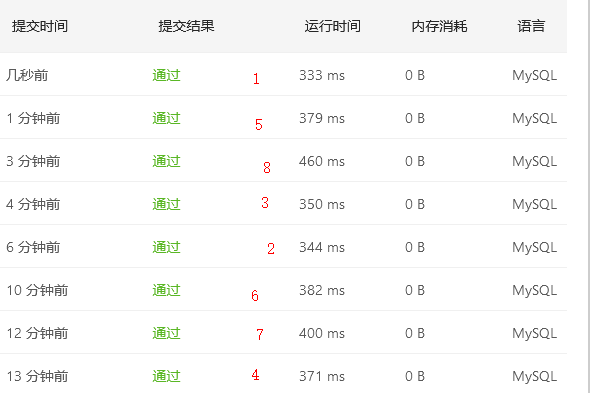试题来自力扣
https://leetcode-cn.com/problems/consecutive-numbers/
1. 构造数据
create table logs (id int primary key ,num int); insert into logs values(1,1); insert into logs values(2,1); insert into logs values(3,1); insert into logs values(4,2); insert into logs values(5,1); insert into logs values(6,2); insert into logs values(7,2); insert into logs values(8,3); insert into logs values(9,2); insert into logs values(10,3); insert into logs values(11,3); insert into logs values(12,3); insert into logs values(13,13); insert into logs values(14,13); insert into logs values(15,13);
2.解题
方法1 三表并联
select distinct a.Num as ConsecutiveNums from logs as a,logs as b,logs as c where a.Num=b.Num and b.Num=c.Num and a.id=b.id-1 and b.id=c.id-1;
执行结果

方法2 使用变量
select distinct Num as ConsecutiveNums from ( select Num, case when @prev = Num then @count := @count + 1 when (@prev := Num) is not null then @count := 1 end as CNT from logs, (select @prev := null,@count := null) as t ) as temp where temp.CNT >= 3;

使用 函数2
select distinct Num as ConsecutiveNums from ( select Num, @cnt:=if(@pre=Num,@cnt:=@cnt+1,@cnt:=1) cnt, @pre:=Num pre from logs,(select @cnt:=0,@pre:=null) a)b where b.cnt>=3;

方法 3 使用row_number() 窗口函数
select distinct o.Num as ConsecutiveNums from (select id,num, row_number() over(partition by num) as nb from logs) o group by o.Num,o.id + 1 - o.nb having count(1) >=3;

稍改一下
select distinct(num) "ConsecutiveNums" from ( select num,(row_number() over(order by id )-row_number() over(partition by num order by id)) rank_ from logs) tmp group by rank_,num having count(rank_)>=3;

方法 4 使用lead() 窗口函数
select distinct Num as ConsecutiveNums from ( select id,Num, lead(Num,1) over(order by id) as Num2,lead(Num,2) over(order by id) as Num3 from logs ) a where Num=Num2 and Num2=Num3;

方法 5 使用lag() 窗口函数
select distinct Num as ConsecutiveNums from ( select id,Num, lag(Num,1) over(order by id) as Num2,lag(Num,2) over(order by id) as Num3 from logs ) a where Num=Num2 and Num2=Num3;

方法6 使用lead() 和lag() 窗口函数 (最快的SQL)
select distinct num as ConsecutiveNums from ( select id,num,lag(num) over(order by id) as lags,lead(num) over(order by id) as leads from logs) as v where num = lags and num = leads

总结

